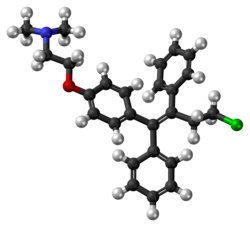User:Mr. Ibrahem/Toremifene
 | |
 | |
| Clinical data | |
|---|---|
| Pronunciation | /ˈtɔːrəmɪfiːn/ |
| Trade names | Fareston, others |
| Other names | (Z)-Toremifene; 4-Chlorotamoxifen; 4-CT; Acapodene; CCRIS-8745; FC-1157; FC-1157a; GTx-006; NK-622; NSC-613680 |
| AHFS/Drugs.com | Monograph |
| MedlinePlus | a608003 |
| License data | |
| Routes of administration | By mouth |
| Drug class | Selective estrogen receptor modulator |
| Pharmacokinetic data | |
| Bioavailability | Good/~100%[1][2] |
| Protein binding | 99.7%[1] |
| Metabolism | Liver (CYP3A4)[5][2] |
| Metabolites | N-Desmethyltoremifene; 4-Hydroxytoremifene; Ospemifene[3][4] |
| Elimination half-life | Toremifene: 3–7 days[1] Metabolites: 4–21 days[2][4][1] |
| Excretion | Feces: 70% (as metabolites)[2] |
| Identifiers | |
| |
| Chemical and physical data | |
| Formula | C26H28ClNO |
| Molar mass | 405.97 g·mol−1 |
| 3D model (JSmol) | |
| |
| |
| (verify) | |
Toremifene, sold under the brand name Fareston among others, is a medication primarily used to treat advanced breast cancer in postmenopausal women.[6] It may also be used to prevent prostate cancer.[6] It is taken by mouth.[6]
Common side effects include hot flashes, sweating, nausea, vomiting, dizziness, vaginal discharge, and vaginal bleeding.[6] It can also cause blood clots, irregular heartbeat, cataracts, visual disturbances, elevated liver enzymes, endometrial hyperplasia, and endometrial cancer.[6] High blood calcium levels can occur in women with bone metastases.[6]
The medication is a selective estrogen receptor modulator (SERM) and hence is a mixed agonist–antagonist of the estrogen receptor (ER), the biological target of estrogens like estradiol.[5][8] It has estrogenic effects in bone, the liver, and the uterus and antiestrogenic effects in the breasts.[9][10][11][5] It is a triphenylethylene derivative and is closely related to tamoxifen.[12]
Toremifene was approved for medical use in Europe in 1996 and the United States in 1997.[13][6] It was the first antiestrogen to be introduced since tamoxifen in 1978.[14] It is available as a generic medication in the United States.[15] In the United Kingdom a month of medication costs the NHS about £30.[7] This amount in the United States costs about 325 USD.[16]
References[edit]
- ^ a b c d Taras TL, Wurz GT, Linares GR, DeGregorio MW (November 2000). "Clinical pharmacokinetics of toremifene". Clin Pharmacokinet. 39 (5): 327–34. doi:10.2165/00003088-200039050-00002. PMID 11108432.
- ^ a b c d Vincent T. DeVita Jr.; Theodore S. Lawrence; Steven A. Rosenberg (7 January 2015). DeVita, Hellman, and Rosenberg's Cancer: Principles & Practice of Oncology. Wolters Kluwer Health. pp. 1126–. ISBN 978-1-4698-9455-3. Archived from the original on 14 April 2020. Retrieved 25 May 2021.
- ^ Bruce A. Chabner; Dan L. Longo (7 December 2011). Cancer Chemotherapy and Biotherapy: Principles and Practice. Lippincott Williams & Wilkins. pp. 659–. ISBN 978-1-4511-4820-6. Archived from the original on 20 June 2017. Retrieved 25 May 2021.
- ^ a b "Archive copy" (PDF). Archived (PDF) from the original on 2021-03-31. Retrieved 2021-05-25.
{{cite web}}: CS1 maint: archived copy as title (link) - ^ a b c Laura Rosenthal; Jacqueline Burchum (17 February 2017). Lehne's Pharmacotherapeutics for Advanced Practice Providers - E-Book. Elsevier Health Sciences. pp. 931–. ISBN 978-0-323-44779-9. Archived from the original on 29 August 2021. Retrieved 25 May 2021.
- ^ a b c d e f g h i "Toremifene Monograph for Professionals". Drugs.com. Archived from the original on 20 January 2021. Retrieved 8 October 2021.
- ^ a b BNF (80 ed.). BMJ Group and the Pharmaceutical Press. September 2020 – March 2021. p. 1006. ISBN 978-0-85711-369-6.
{{cite book}}: CS1 maint: date format (link) - ^ David Schiff; Isabel Arrillaga; Patrick Y. Wen (16 September 2017). Cancer Neurology in Clinical Practice: Neurological Complications of Cancer and its Treatment. Humana Press. pp. 296–. ISBN 978-3-319-57901-6. Archived from the original on 29 August 2021. Retrieved 25 May 2021.
- ^ William R. Miller; James N. Ingle (8 March 2002). Endocrine Therapy in Breast Cancer. CRC Press. pp. 55–57. ISBN 978-0-203-90983-6. Archived from the original on 19 February 2020. Retrieved 25 May 2021.
- ^ Monica Morrow; Virgil Craig Jordan (2003). Managing Breast Cancer Risk. PMPH-USA. pp. 192–. ISBN 978-1-55009-260-8. Archived from the original on 2021-08-29. Retrieved 2021-05-25.
- ^ Selective Estrogen Receptor Modulators—Advances in Research and Application: 2013 Edition: ScholarlyBrief. ScholarlyEditions. 1 May 2013. pp. 51–. ISBN 978-1-4901-0447-8. Archived from the original on 29 August 2021. Retrieved 25 May 2021.
- ^ Antonio Cano; Joacquim Calaf i Alsina; Jose Luis Duenas-Diez (22 September 2006). Selective Estrogen Receptor Modulators: A New Brand of Multitarget Drugs. Springer Science & Business Media. pp. 52–. ISBN 978-3-540-34742-2. Archived from the original on 24 June 2021. Retrieved 25 May 2021.
- ^ "Fareston". Archived from the original on 25 November 2020. Retrieved 8 October 2021.
- ^ Philip J. DiSaia; William T. Creasman; Robert S Mannel; D. Scott McMeekin, David G Mutch (4 February 2017). Clinical Gynecologic Oncology E-Book. Elsevier Health Sciences. pp. 124–. ISBN 978-0-323-44316-6. Archived from the original on 29 August 2021. Retrieved 25 May 2021.
- ^ "Generic Fareston Availability - Drugs.com". Drugs.com. Archived from the original on 2017-12-29. Retrieved 2019-04-19.
- ^ "Toremifene Prices, Coupons & Savings Tips - GoodRx". GoodRx. Archived from the original on 3 May 2016. Retrieved 8 October 2021.
